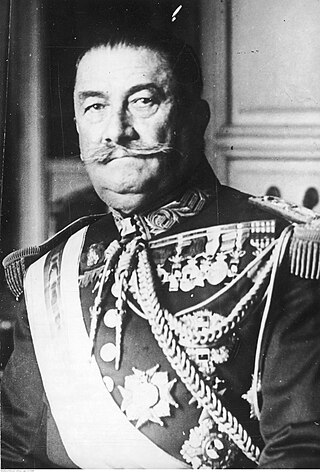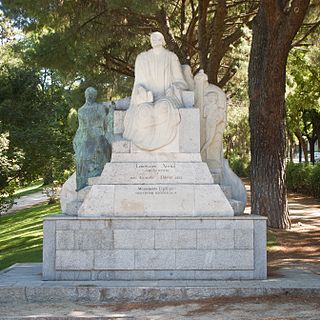This article needs additional citations for verification .(October 2022) |
| |||||
| Decades: | |||||
|---|---|---|---|---|---|
| See also: | Other events of 1931 List of years in Spain | ||||
Events in the year 1931 in Spain .
This article needs additional citations for verification .(October 2022) |
| |||||
| Decades: | |||||
|---|---|---|---|---|---|
| See also: | Other events of 1931 List of years in Spain | ||||
Events in the year 1931 in Spain .

The Republican Left was a Spanish republican party founded in 1934.
Straperlo was a scheme which originated in the Netherlands in the 1930s and was then introduced in Spain. In essence it was a fraudulent roulette which could be controlled electrically with the push of a button. The ensuing scandal was one of the several causes of the fall of the Republican government and the polarization of the parliament, which finally led to the Spanish Civil War (1936–1939).

President of the Republic was the title of the head of state during the Second Spanish Republic (1931–1939). The office was based on the model of the Weimar Republic, then still in power in Germany, and a compromise between the French and American presidential systems.

Manuel Portela y Valladares was a Spanish political figure during the Second Spanish Republic. He served as the 43rd Attorney General of Spain between 1912 and 1913.

Niceto Alcalá-Zamora y Torres was a Spanish lawyer and politician who served, briefly, as the first prime minister of the Second Spanish Republic, and then—from 1931 to 1936—as its president.

Agustín García-Gasco y Vicente was a Spanish Cardinal of the Catholic Church. He served as Archbishop of Valencia from 1992 to 2009, and was elevated to the cardinalate in 2007.

The Spanish Episcopal Conference is an administrative institution composed of all the bishops of the dioceses of Spain and Andorra, in communion with the Roman Pontiff and under his authority. Its purpose is the joint exercise certain pastoral functions of the episcopate on the faithful of their territory, under common law and statutes, in order to promote the life of the Church, to strengthen its mission of evangelization and respond more effectively to the greater good that the Church should seek to men.
Events in the year 1934 in Spain.
Events in the year 1950 in Mexico.
Events in the year 1932 in Spain.
Events in the year 1933 in Spain.
Events in the year 1935 in Spain.
Events in the year 1949 in Spain.
The Provisional Government of the Second Spanish Republic was the government that held political power in Spain from the fall of Alfonso XIII of Spain on April 14, 1931 and the proclamation of the Second Spanish Republic until the approval of the Spanish Constitution of 1931 on December 9 and the formation of the first regular government on December 15. The King's departure created the need for a provisional government, whose first president was Niceto Alcalá Zamora, who presided until 1936, when Manuel Azaña took over. The new constitution established freedom of speech, freedom of association, extended voting privileges to women, allowed divorce, and stripped the Spanish nobility of their special legal status.
Agustín Viñuales Pardo was a Spanish lawyer, economist and politician who was briefly Minister of Finance in 1933.

The Dictablanda of Dámaso Berenguer, or Dámaso Berenguer's dictatorship was the final period of the Spanish Restoration and of King Alfonso XIII’s reign. This period saw two different governments: Dámaso Berenguer’s government, formed in January 1930 with the goal of reestablishing “constitutional normalcy” following Primo de Rivera’s dictatorship, and President Juan Bautista Aznar’s government, formed a year later. The latter paved the way to the proclamation of the Second Spanish Republic. The term dictablanda was used by the press to refer to the ambivalence of Berenguer’s government, which neither continued the model of the former dictatorship nor did it fully reestablish the 1876 Constitution.

The Monument to Concepción Arenal is an instance of public art in Madrid, Spain. Located at the Parque del Oeste, it is dedicated to Concepción Arenal, 19th-century standout jurist and precursor of feminism.

Rafael Salazar Alonso was a Spanish lawyer, newspaper proprietor and politician who engaged in left-wing and right-wing politics. He was the mayor of Madrid and a government minister. He was executed by the Republican authorities two months after the Spanish Civil War started.

Gloria Begué Cantón was a Spanish professor, jurist, senator and magistrate. She was the first female law school professor in Spain and was a law educator at Complutense University of Madrid and the University of Salamanca.